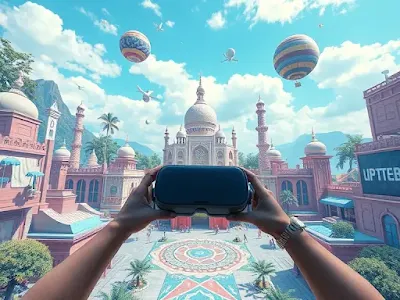The gaming industry has always been at the forefront of technological innovation, consistently evolving to deliver more immersive, engaging, and interactive experiences. As we move deeper into 2025, several groundbreaking trends are shaping the future of gaming. Let’s explore some of the most impactful advancements in gaming technology.
1. Cloud Gaming Takes Center Stage
Cloud gaming is revolutionizing how games are accessed and played. Platforms like NVIDIA GeForce Now, Xbox Cloud Gaming, and PlayStation Now are leading the charge, enabling players to stream high-quality games without requiring powerful hardware. With advancements in 5G and edge computing, latency issues are diminishing, making cloud gaming more accessible and reliable.
2. AI-Powered Gameplay
Artificial Intelligence is enhancing both game design and player experience. AI-driven NPCs (Non-Player Characters) are becoming smarter and more realistic, offering dynamic interactions that adapt to player choices. Additionally, AI is being used to optimize game development processes, from procedural content generation to real-time bug detection.
3. Immersive Virtual Reality (VR) and Augmented Reality (AR)
VR and AR technologies continue to blur the lines between the virtual and physical worlds. Devices like the Meta Quest 3 and Apple Vision Pro are setting new standards for immersion, offering higher resolutions, wider fields of view, and enhanced spatial audio. AR gaming, in particular, is expanding, with innovative titles integrating real-world environments into gameplay.
4. Next-Generation Graphics and Real-Time Ray Tracing
The latest GPUs from NVIDIA, AMD, and Intel are pushing the boundaries of visual fidelity. Real-time ray tracing is now a staple in many AAA games, delivering lifelike lighting, reflections, and shadows. Combined with advanced rendering techniques, these technologies are creating hyper-realistic environments that captivate players.
5. Cross-Platform Play and Unified Ecosystems
Cross-platform gaming is becoming the norm, breaking down barriers between consoles, PCs, and mobile devices. This trend is fostering a more inclusive gaming community, allowing friends to play together regardless of their hardware. Unified ecosystems, such as Xbox Game Pass and PlayStation Plus, further enhance accessibility by offering vast libraries of games across multiple platforms.
6. Blockchain and Play-to-Earn Games
Blockchain technology is reshaping the gaming economy. Play-to-earn (P2E) games, powered by NFTs and cryptocurrencies, allow players to monetize their gaming experiences. While this trend is still polarizing, it represents a significant shift in how gamers perceive in-game assets and ownership.
7. Haptic Feedback and Advanced Controllers
Innovations in haptic technology are making gaming more tactile and engaging. Devices like the PlayStation DualSense controller and third-party peripherals offer precise feedback, enhancing the sense of immersion. Advanced controllers with customizable buttons and adaptive triggers are becoming increasingly popular among competitive gamers.
8. Esports and Live Streaming Evolution
The esports industry is booming, with larger tournaments, bigger prize pools, and a growing global audience. Platforms like Twitch, YouTube Gaming, and Kick are continuously evolving to offer better monetization options for streamers and more engaging content for viewers. Interactive features, such as live polls and audience-driven gameplay, are enhancing the spectator experience.
9. Sustainability in Gaming
Sustainability is gaining traction as a priority in game development. Studios are adopting eco-friendly practices, such as energy-efficient servers and sustainable packaging. Furthermore, digital-only releases are reducing the environmental impact associated with physical game production and distribution.
10. AI-Generated Worlds and Narratives
Procedural generation has reached new heights, with AI crafting vast, intricate game worlds and storylines. Tools like ChatGPT and generative AI models are being integrated into games to offer personalized narratives and endless replayability, ensuring that no two playthroughs are the same.
Conclusion
The future of gaming technology is incredibly exciting, driven by innovations that enhance creativity, connectivity, and interactivity. As these trends continue to evolve, gamers can look forward to experiences that are not only visually stunning but also deeply immersive and engaging. Whether it’s through cloud gaming, AI advancements, or groundbreaking hardware, the gaming industry is poised to redefine entertainment in ways we’ve never imagined.


.webp)
.webp)















0 Comments